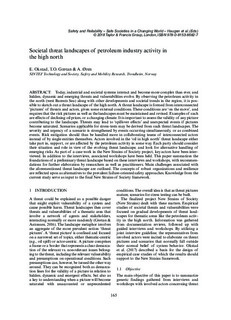| dc.contributor.author | Okstad, Eivind Halvard | |
| dc.contributor.author | Grøtan, Tor Olav | |
| dc.contributor.author | Øren, Anita | |
| dc.date.accessioned | 2018-12-05T08:45:13Z | |
| dc.date.available | 2018-12-05T08:45:13Z | |
| dc.date.created | 2018-07-02T14:25:23Z | |
| dc.date.issued | 2018 | |
| dc.identifier.citation | Safety and Reliability - Safe Societies in a Changing World , 2018, 165-172 | nb_NO |
| dc.identifier.isbn | 978-1-351-17466-4 | |
| dc.identifier.uri | http://hdl.handle.net/11250/2576093 | |
| dc.description.abstract | Today, industrial and societal systems interact and become more complex than ever, and hidden, dynamic and emerging threats and vulnerabilities evolve. By observing the petroleum activity in the north (west Barents Sea) along with other developments and societal trends in the region, it is possible to sketch out a threat landscape of the high north. A threat landscape is formed from interconnected ‘pictures’ of threats and actors, given some external conditions. These conditions are ‘on the move’, and requires that the risk pictures as well as the landscapes must be maintained and revised. Examples of such are effects of declining oil prices, or a changing climate. It is important to assess the validity of any picture contributing to the landscape. Threats may lead to ‘spillover effects’ and unexpected events if pictures become saturated. Scenarios applicable for stress-tests may be derived from such threat landscapes. The severity and urgency of a scenario is strengthened by events occurring simultaneously, or as combined events. Risk mitigation should thus be handled more in collaborating teams of interconnected actors instead of by single entities themselves. Actors involved in the ‘oil in high north’ threat landscape either take part in, support, or are affected by the petroleum activity in some way. Each party should consider their situation and role in view of the evolving threat landscape, and look for alternative handling of emerging risks. As part of a case work in the New Strains of Society project, key actors have been interviewed. In addition to the interviews, associated workshops have been held. This paper summarizes the foundations of a preliminary threat landscape based on these interviews and workshops, with recommendations for further elaboration by researchers as well as practitioners. Main challenges associated with the aforementioned threat landscape are outlined. The concepts of robust organizations and resilience are reflected upon as alternatives to the prevalent failure-oriented safety approaches. Knowledge from the current study serve as input to the final New Strains of Society framework. | nb_NO |
| dc.language.iso | eng | nb_NO |
| dc.relation.ispartof | Safety and Reliability - Safe Societies in a Changing World | |
| dc.title | Societal threat landscapes of petroleum industry activity in the high north | nb_NO |
| dc.type | Chapter | nb_NO |
| dc.description.version | publishedVersion | nb_NO |
| dc.subject.nsi | VDP::Samfunnsvitenskap: 200 | nb_NO |
| dc.subject.nsi | VDP::Social sciences: 200 | nb_NO |
| dc.source.pagenumber | 165-172 | nb_NO |
| dc.identifier.cristin | 1595236 | |
| dc.relation.project | Norges forskningsråd: 238093 | nb_NO |
| cristin.unitcode | 7401,90,13,0 | |
| cristin.unitname | Software Engineering, Safety and Security | |
| cristin.ispublished | true | |
| cristin.fulltext | original | |
| cristin.qualitycode | 1 | |
